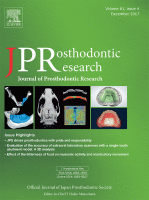Special Edition
Volume 61, Issue 4
Displaying 1-18 of 18 articles from this issue
- |<
- <
- 1
- >
- >|
Editorial
-
2017Volume 61Issue 4 Pages 351-352
Published: 2017
Released on J-STAGE: November 09, 2017
Download PDF (815K)
Review
-
2017Volume 61Issue 4 Pages 353-362
Published: 2017
Released on J-STAGE: November 09, 2017
Download PDF (1300K)
Original Articles
-
2017Volume 61Issue 4 Pages 363-370
Published: 2017
Released on J-STAGE: November 09, 2017
Download PDF (2480K) -
2017Volume 61Issue 4 Pages 371-378
Published: 2017
Released on J-STAGE: November 09, 2017
Download PDF (1934K) -
2017Volume 61Issue 4 Pages 379-386
Published: 2017
Released on J-STAGE: November 09, 2017
Download PDF (1318K) -
2017Volume 61Issue 4 Pages 387-392
Published: 2017
Released on J-STAGE: November 09, 2017
Download PDF (688K) -
2017Volume 61Issue 4 Pages 393-402
Published: 2017
Released on J-STAGE: November 09, 2017
Download PDF (2514K) -
2017Volume 61Issue 4 Pages 403-411
Published: 2017
Released on J-STAGE: November 09, 2017
Download PDF (1651K) -
2017Volume 61Issue 4 Pages 412-418
Published: 2017
Released on J-STAGE: November 09, 2017
Download PDF (1068K) -
2017Volume 61Issue 4 Pages 419-425
Published: 2017
Released on J-STAGE: November 09, 2017
Download PDF (567K) -
2017Volume 61Issue 4 Pages 426-431
Published: 2017
Released on J-STAGE: November 09, 2017
Download PDF (693K) -
2017Volume 61Issue 4 Pages 432-438
Published: 2017
Released on J-STAGE: November 09, 2017
Download PDF (676K) -
2017Volume 61Issue 4 Pages 439-449
Published: 2017
Released on J-STAGE: November 09, 2017
Download PDF (720K) -
2017Volume 61Issue 4 Pages 450-459
Published: 2017
Released on J-STAGE: November 09, 2017
Download PDF (1717K) -
2017Volume 61Issue 4 Pages 460-463
Published: 2017
Released on J-STAGE: November 09, 2017
Download PDF (968K) -
2017Volume 61Issue 4 Pages 464-470
Published: 2017
Released on J-STAGE: November 09, 2017
Download PDF (1118K) -
2017Volume 61Issue 4 Pages 471-479
Published: 2017
Released on J-STAGE: November 09, 2017
Download PDF (2753K) -
2017Volume 61Issue 4 Pages 480-490
Published: 2017
Released on J-STAGE: November 09, 2017
Download PDF (621K)
- |<
- <
- 1
- >
- >|
